Includes per person per stay:
- 1 x Glass of wine in the hotel lobby
- 1 x 2-course menu (Chefs choice)
- 1 x Overnight accommodation
- 1 x Breakfast buffet
3.60526316079051 of 5 Stars

Includes per person per stay:
Click the "See calendar and prices" button to choose dates and see the room selection.
See calendar and prices: Summer stay in beautiful SilkeborgHotel Dania commands a central location in Silkeborg, surrounded by shops, sights and attractions and close to the woods and lakes. Dating from 1848, the hotel has been carefully refurbished to preserve its special charm and atmosphere. The hotel restaurant Brasserie Underhuset serves a cuisine in a class of its own.
Torvet 5, 8600 Silkeborg
Show map

Includes per person per night:

Breakfast is not included
Includes per person per night:
Breakfast is not included in room rate.

Includes per person per stay:
The stay does not include beverages

Min. 3 days/ 2 nights
Includes per person per day:

Includes per person per night:

Minimum 3 days / 2 nights
Includes per person per night:

Includes per person per night:
Overnight accommodation
Breakfast

No Refund / No Cancellation / no payment with gift voucher
Includes per person per night:
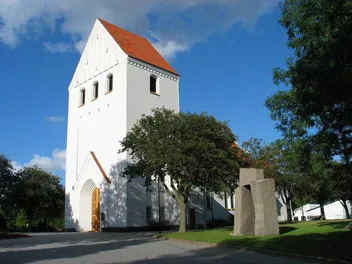
0.2 km
Under the project management of the expert Copenhagen church architect, V. Hardie-Fischer, and with local architect E. Hermansen on site, extensive restoration work was carried out on Alderslyst church from 1975–77. All of the windows in the church were fitted with stained glass made by the artist Sven Havsteen-Mikkelsen. The churchyard contains four stone sculptures by Erik Heide. The pathway between the churchyard and the parish hall is marked by 12 steles, also by Erik Heide.
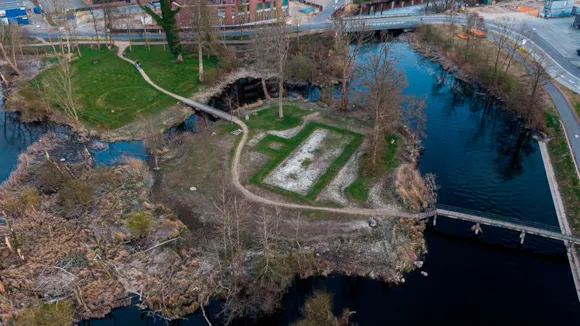
1.07 km
Silkeborg Castle, the first of its kind, was constructed in 1385 as a simple wooden structure with palisades. Later, it was replaced by a stone house, and in the early 1500s, a main building in stone, a courtyard, and a stable yard were added.
Silkeborg Castle received visits from several royal guests, including Frederick 2 and Christian 4, who frequently stayed in the main building known as "The Great Stone House," especially during hunting trips in Mid Jutland.
During the 17th century, the castle was heavily damaged during the Swedish wars when Silkeborg was occupied three times by Swedish troops who ravaged the castle buildings.
The last remnants of the castle were demolished in 1726 after having fallen into disrepair for several years.
Today, the layout of both the main building and the castle courtyard is marked with earthworks.
You can access the area via a bridge over the Gudenå River at Silkeborg Langsø or from the Papirfabrikken area.
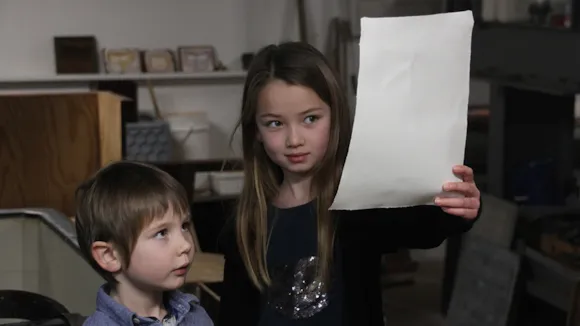
1.23 km
The Paper Museum is a living museum where handmade paper is still being produced, and the audience can experience the magic of paper being made.
The museum also contains an exhibition on Danish paper making through the ages and on Silkeborg Paper Factory as well as changing exhibitions related to paper production.
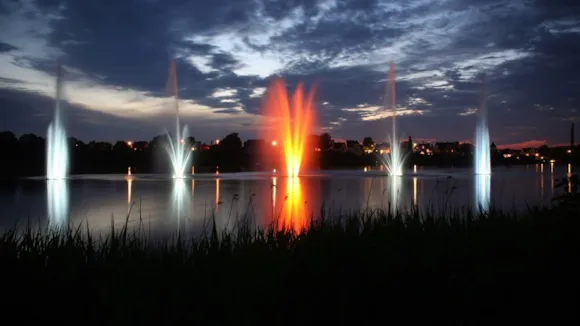
1.26 km
Silkeborg Langsø's fountain is one of the largest in Northern Europe, with the capacity to shoot up to 355,000 liters of water up to 30 meters into the air. The fountain consists of a total of five fountains that project water into the air with varying strengths. The tallest, central jet reaches a height of 30-33 meters, while the others reach 20 and 3 meters, respectively.
Projectors within the fountains ensure a spectacular light show, with colors changing according to a pre-programmed sequence lasting approximately 35-40 minutes.
Today, the fountain is located in front of Silkeborg City Hall on Søvej. Previously, it was situated further out in the lake, but it was moved closer to the shore because it was disturbing the local birdlife.
However, this new location posed new challenges, as strong gusts of wind could send water directly towards cyclists and car windshields on the road alongside the lake. Therefore, the fountain is now connected to a weather station, automatically turning it off when the wind comes from a specific direction and reaches a certain speed.
Normally, you can see the fountain in action from May 1st to September 20th between 12:00 PM and 12:00 AM, and on weekends from 9:00 AM to 12:00 AM. During major events such as Regattaen and the Riverboat Jazz Festival, the fountain often continues until 3:00 AM.
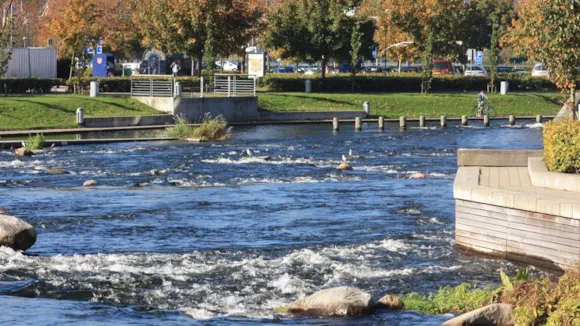
1.43 km
The River Gudenå has been dammed up by the current Langebro bridge in Silkeborg since some time in the Middle Ages. A water mill was established at the spot, where the water power was used for grinding corn. When Silkeborg Papirfabrik opened in 1844, the mill was shut down and water power was instead used to operate the machines in the factory.
When the paper mill closed in 2000, the new owners of the factory area voluntarily relinquished the right to exploit the water power. The dam was removed, as was a turbine house that stood there. This opened up the opportunity to establish the long-awaited passage for fish and other small animals, known as a fauna passage. The passage – the longest of its kind in Denmark at 90 metres – was opened in June 2004.
10,000 tonnes of boulders, 200 tonnes of iron, 300 tonnes of concrete and 20 tonnes of wood were used for the ladder which leads the water flow in a zigzag through a drop of approximately two metres from the harbour and down to the end of the ladder. The water flow is automatically controlled by three large dam gates, which ensure that the water level only fluctuates within a pre-defined limit. Next to the passage is a canal that leads canoes and boats from the lock at the harbour out into the river course.
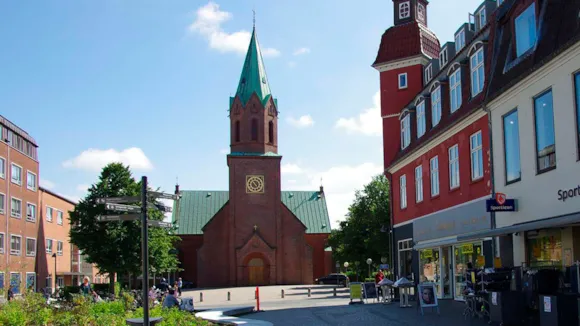
1.49 km
The beautiful altarpiece is carved in gold-plated wood. The motif depicts Christ on the cross flanked by the Virgin Mary and the apostle John. At the bottom, a frieze runs with the 12 apostles surrounding Jesus as the savior and judge in the center.
The beautiful stained glass mosaics in the apse depict "The Good Shepherd" and "The Sower." Also, take note of the splendid organ facade from 1943, on which the former king's coat of arms can be seen.
The church's carillon consists of 49 bells and plays every day at 8:00 AM, 12:00 PM, 2:00 PM, 4:00 PM, and 6:00 PM.
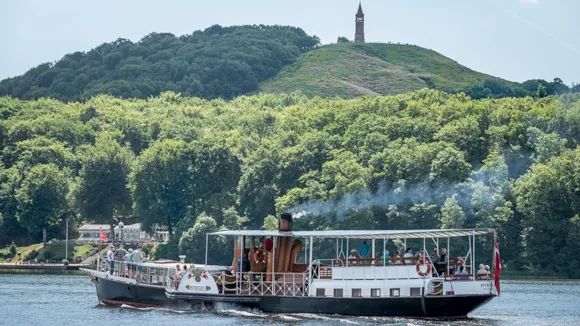
1.51 km
Hjejlen is the world’s oldest original coal-fired paddle steamer still in operation. Daily throughout the summer, Hjejlen and the other excursion boats in the Hjejle fleet sail from Silkeborg to Himmelbjerget and on to the small station town of Laven.
The trip from Silkeborg to Himmelbjerget takes 1 hour and 15 minutes. Finally, you have the opportunity to experience the scenic Silkeborg lakes on an evening trip on board Hjejlen or one of the other boats.
View timetable on Hjejlen’s website here.
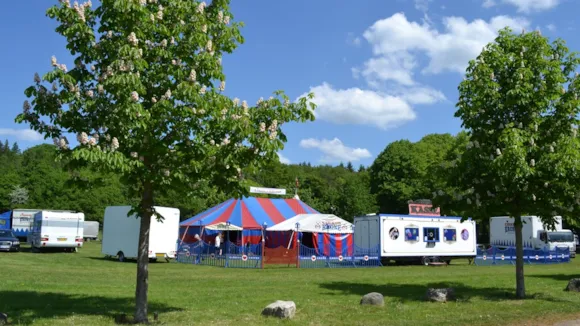
1.51 km
As the name suggests, Cirkuspladsen (the circus ground) in Kastaniehøjvej, Silkeborg is used for circus performances, but it also provides the setting for animal shows and a temporary campsite during the annual Country Festival, and a marketplace for the sale of fireworks up leading up to New Year’s Eve.
#danmarksoutdoorhovedstad #visitsilkeborg #visitaarhusregion

1.58 km
On 6 May 1950, a dead body was found in a bog near Bjældskovdal about ten kilometres west of Silkeborg. The police was called by two brothers who were out cutting peat, but suddenly stumbled upon a body. The brothers were convinced that the deceased had passed away quite recently, since the body was in such good condition.
When they told the police that the body had been found 2.5 metres below the peat, the police immediately realised that the case was probably one for Silkeborg Museum rather than the police. Therefore, both police and museum officials went out to the bog where they saw the crouched bog body lie about 60 metres out from solid soil. It was clear to everyone that this was a significant discovery, and an archaeologist from Aarhus was sent for in order for the excavation to be conducted properly.
Examinations of the Tollund Man revealed that it was a man between 30-40 years of age who had been strangled with the leather strap he still wore around his neck. Later scans of the bog body have disclosed that the man probably died from hanging. Today, Tollund Man is on display at Museum Silkeborg and is famed for being one of the best-preserved bog bodies in the world. Not far from where the Tollund Man was excavated, another body was found in the 1930s – the Elling Woman. She too can be seen at Museum Silkeborg.
Listen to the song: TOLLUND MAN - Please Tell Us What Your Name Was

3.39 km
Inside, AQUA offers underwater experiences with panoramic views across large lakes, and fascinating exhibitions on the wildlife of the Danish lakes and water courses. You can discover ferocious pike through large, panoramic windows and follow the record giant catfish, which can easily swallow a whole duck. See also our otters up close when they catch fish under water.
Outside, you will find the AQUA park, which is home to our beloved beavers, otters, racoons, storks and lots of other animals. There is also a wilderness trail and a large water play area with water canons, sluices, paddling pool and other fun activities. The playground is fun for all ages. The playground consists of several activities in many heights, lock systems, gynger- and cable car, sandbox, etc. One thing is certain - remember changing clothes - you are sure to wet the playground of AQUA Aquarium & Wildlife Park.
Next to the playground is also large lunch area with barbecue facilities, Café bird table and toilets. Daily programme of activities, including animal feeding.
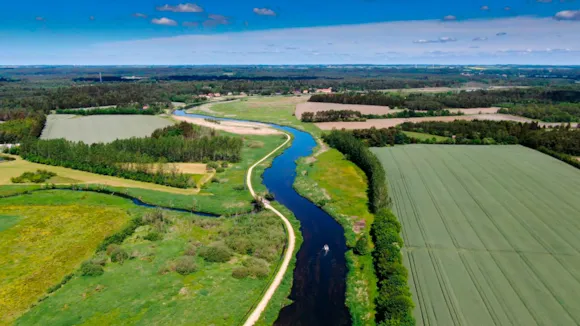
4.6 km
The Gudenå River is approximately 160 km long and the closest we in Denmark get to a "real" river. The river originates in Tinnet Krat northwest of Tørring and flows into Randers Fjord at Randers Bridge.
At Randers, Randers Fjord is forming a river delta with a number of small islands. This delta is one of the few major inland deltas in Denmark, as it was formed at the mouth of Randers Fjord rather than directly into the sea.
In the past, the Gudenå River was one of Jutland's main routes with settlements and later villages along the river. It was mainly peat and agricultural products and, with the establishment of the paper mill in Silkeborg in 1844, paper that was transported. Today, the Gudenå River attracts many to row on the river annually in either a canoe, kayak or rowing boat.
For anglers - due to the power of its water volume and depth - the Gudenå River is an challenging angling water and has a very attractive salmon fishery. In Gudenåen you can catch brook trout, sea trout, salmon, eel, pike, sand species and skull.
The trek path is a nature-tramp path that follows the Gudenåen from Silkeborg to Randers - a total of approx. 70 km. You can experience unique nature in a varied and sometimes difficult to access landscape.
A canoe trip on the Gudenå is both a scenic and challenging experience. The river is widely used during the summer by canoeists who go on a trip of one or more days duration. Sailing is allowed around the clock and throughout the year. The river is home to more than 80 plant species, of which 44 aquatic species.
Find more than 500 activities and information to do along the Gudenå.
All motor boats used on the the River Gudenå and Lakes of Silkeborg must be registered. This means your boat must have a guest number, which can be purchased here.

12.22 km
Until the mid-19th century, Himmelbjerget was perceived as the highest point in Denmark. With its 147 meters above sea level, the legendary Himmelbjerg is certainly an impressive giant, and the steep hill down to the beautiful Julsø adds to the mountain romance.
At the top of Himmelbjerget stands the Himmelbjerg Tower, which is 25 meters high and was erected as a memorial to King Frederik VII, who on June 5, 1849, gave the Danish people their free constitution.
However, it is not only from the top of Himmelbjerget that you can enjoy a fantastic view. The forests south of the mountain hide several amazing viewpoints and good opportunities to get away from the lively visitor areas.
The area around Himmelbjerget has a large and diverse trail system, where you can take shorter walks or combine several routes to create longer ones. You can get a good overview of the marked hiking trails in the Nature Agency's brochure on Himmelbjerget, Sletten, and Slåensø.
Visit BestigBjerge.dk, embark on the 52 km long Himmelbjergrute around the lakes, or be inspired by the many other outdoor activities in the Lake Distirct here.
The name Himmelbjerget appears in writing as early as the beginning of the 18th century when a dramatic wolf hunt was held on the mountain. It is, therefore, an old local place name and not a romantic term introduced by the first tourists.
Himmelbjerget has been a popular destination for generations, and already in the late 1830s, the poet priest St. St. Blicher made the mountain famous as the setting for his folk meetings. Nowadays, people still meet on the mountain to celebrate democracy and the constitution. Landscape painters spread knowledge of the place's beauties through their depictions of hills, forests, and views. Then came beer stalls, pavilions, hotels, ice cream kiosks, and souvenir shops.
By studying the memorials on Himmelbjerget, you can also gain insight into how the Constitution of the Danish Realm came about – and even get the story in your ear as a podcast. For example, read and hear more about St. St. Blicher's memorial on Himmelbjerget, or read more about Kvinde Egen, which was planted in 1915.
According to Norse mythology, Himmelbjerget is the highest mountain in the gods' world, known as Asgard. According to the myth, the god Heimdal lives on Himmelbjerget and guards Asgard at the end of the rainbow Bifrost, to prevent giants from sneaking in.
Combine the experience with a trip on one of the Hjejle boats, as has been customary since 1861.
Since 1861, the Hjejle Company has been sailing tourists to Himmelbjerget. Therefore, souvenir stalls have also existed on the site since the 1800s. At that time, it was an offshoot of the local area's wooden shoe production, where the wooden shoe boys carved small figures and "Himmelbjerg sticks," which were sold to tourists.
See sailing times and buy tickets here.
With modern measuring instruments, it has been determined that Møllehøj (170.86), Yding Skovhøj (170.77), and Ejer Bavnehøj (170.35) are the highest points in Denmark - and they are all located in the Søhøjlandet region.
Read more about the 'hills' here.